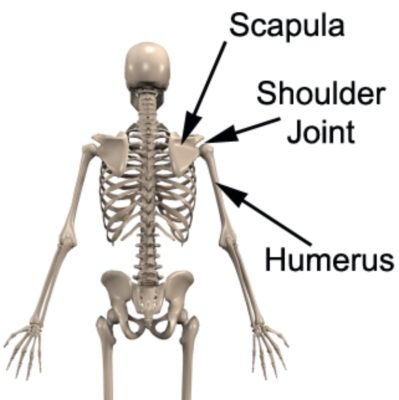Scapula Anatomy: Understanding the Shoulder Blade
Updated:
The scapula, also known as the shoulder blade, is a flat, triangular bone located on the upper back of the body. It forms the posterior part of the shoulder girdle, along with the clavicle and humerus, and provides attachment sites for muscles that enable movement and stability of the shoulder joint. In this article, we will explore the anatomy of the scapula, including its bony landmarks, muscular attachments, and related injuries.

Figure 1 – Scapula Anatomy
Scapula Anatomy: Bony Landmarks
The scapula has three borders and three angles that provide important bony landmarks for muscle and ligament attachment. The superior border of the scapula is the shortest border, and it runs horizontally across the top of the bone. The medial border of the scapula is the longest border, and it runs vertically along the side of the bone closest to the spine. The lateral border of the scapula runs vertically along the side of the bone away from the spine (Figure 1).
The three angles of the scapula are the superior angle, inferior angle, and lateral angle. The superior angle is located at the junction of the superior and medial borders of the scapula. The inferior angle is located at the junction of the medial and lateral borders of the scapula. The lateral angle is located at the junction of the superior and lateral borders of the scapula.
Scapula Anatomy: Muscular Attachments
The scapula has several muscular attachments that are crucial for the movement and stability of the shoulder joint. The trapezius muscle attaches to the superior nuchal line of the scapula and the spine of the scapula, and it helps to elevate, retract, and rotate the scapula. The serratus anterior muscle attaches to the medial border of the scapula and helps to protract, or move the scapula forward, and upwardly rotate the scapula. The levator scapulae muscle attaches to the superior angle of the scapula and helps to elevate the scapula. The rhomboid major and rhomboid minor muscles attach to the medial border of the scapula and help to retract, or move the scapula backward.
Injuries of the Scapula
The scapula is less vulnerable to injuries than the clavicle, but it can still be affected by various types of trauma. Fractures of the scapula are relatively uncommon, but they can occur in high-impact sports or motor vehicle accidents. Dislocation of the scapula can also occur, but it is very rare. Shoulder impingement syndrome, in which the soft tissues of the shoulder are compressed against the scapula, can cause pain and inflammation in the shoulder.
Conclusion
The scapula plays an important role in the stability and mobility of the shoulder joint. Its bony landmarks and muscular attachments provide the foundation for movement and support, allowing for a wide range of shoulder motion. Although injuries to the scapula are less common than injuries to the clavicle, they can still cause significant pain and disability. Understanding the anatomy of the scapula can help prevent and manage these injuries, allowing for optimal function and performance of the shoulder joint.
References:
“Scapula Anatomy” by Healthline (https://www.healthline.com/human-body-maps/scapula)
“Scapula Fracture” by American Academy of Orthopaedic Surgeons (https://orthoinfo.aaos.org/en/diseases–conditions/scapula-shoulder-blade-fractures/)

Link to this Page
If you would like to link to this article on your website, simply copy the code below and add it to your page:
<a href="https://physioadvisor.com.au/health/anatomy/bones/scapula-anatomy-understanding-the-shoulder-blade”>Scapula Anatomy: Understanding the Shoulder Blade – PhysioAdvisor.com</a><br/>Learn about shoulder blade (scapula) anatomy including bony land marks, muscular attachments, injuries on PhysioAdvisor.
Return to the top of Scapula Anatomy: Understanding the Shoulder Blade.
